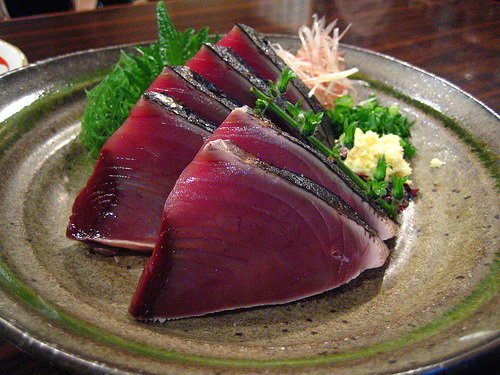Tataki on:
[Wikipedia]
[Google]
[Amazon]
 Two methods of preparing fish or meat in
Two methods of preparing fish or meat in
 Two methods of preparing fish or meat in
Two methods of preparing fish or meat in Japanese cuisine
Japanese cuisine encompasses the regional and traditional foods of Japan, which have developed through centuries of political, economic, and social changes. The traditional cuisine of Japan ( Japanese: ) is based on rice with miso soup and oth ...
are called or . In Japanese
Japanese may refer to:
* Something from or related to Japan, an island country in East Asia
* Japanese language, spoken mainly in Japan
* Japanese people, the ethnic group that identifies with Japan through ancestry or culture
** Japanese diaspor ...
, means "pounded" or "hit into pieces".
Cooked food
In the first method, the meat or fish is seared very briefly over a hot flame or in a pan, and can be briefly marinated invinegar
Vinegar is an aqueous solution of acetic acid and trace compounds that may include flavorings. Vinegar typically contains 5–8% acetic acid by volume. Usually, the acetic acid is produced by a double fermentation, converting simple sugars to eth ...
, sliced thin, and seasoned with ginger
Ginger (''Zingiber officinale'') is a flowering plant whose rhizome, ginger root or ginger, is widely used as a spice and a folk medicine. It is a herbaceous perennial which grows annual pseudostems (false stems made of the rolled bases of ...
(which is ground or pounded into a paste, hence the name). Food so prepared can also be served like sashimi
is a Japanese delicacy consisting of fresh raw fish or meat sliced into thin pieces and often eaten with soy sauce.
Origin
The word ''sashimi'' means "pierced body", i.e. " 刺身" = ''sashimi'', where 刺 し = ''sashi'' (pierced, stu ...
with soy sauce and garnishes.
The method originated in Tosa Province
was a province of Japan in the area of southern Shikoku. Nussbaum, Louis-Frédéric. (2005). "''Tosa''" in . Tosa bordered on Awa to the northeast, and Iyo to the northwest. Its abbreviated form name was . In terms of the Gokishichidō syst ...
, now part of Kōchi Prefecture, where it was applied to bonito
Bonitos are a tribe of medium-sized, ray-finned predatory fish in the family Scombridae – a family it shares with the mackerel, tuna, and Spanish mackerel tribes, and also the butterfly kingfish. Also called the tribe Sardini, it consists ...
(). Lore has it that it was developed by Sakamoto Ryōma
was a Japanese ''samurai'', a '' shishi'' and influential figure of the ''Bakumatsu'' and establishment of the Empire of Japan in the late Edo period.
He was a low-ranking ''samurai'' from the Tosa Domain on Shikoku and became an active oppo ...
, a 19th-century rebel samurai
were the hereditary military nobility and officer caste of medieval and early-modern Japan from the late 12th century until their abolition in 1876. They were the well-paid retainers of the '' daimyo'' (the great feudal landholders). They ...
, who picked up the European technique of grilling
Grilling is a form of cooking that involves dry heat applied to the surface of food, commonly from above, below or from the side. Grilling usually involves a significant amount of direct, radiant heat, and tends to be used for cooking meat a ...
meat from the foreigners resident in Nagasaki
is the capital and the largest city of Nagasaki Prefecture on the island of Kyushu in Japan.
It became the sole port used for trade with the Portuguese and Dutch during the 16th through 19th centuries. The Hidden Christian Sites in the ...
.
Uncooked food
In the second method, it is the food that is "hit into pieces". Fish such as tuna or horse mackerel are chopped and mixed with garnishes such as garlic, ginger, green onions or leaves. Soy sauce may be poured over the chopped mixture before consumption.References
Cooking techniques Japanese cuisine Uncooked meat dishes {{Japan-cuisine-stub